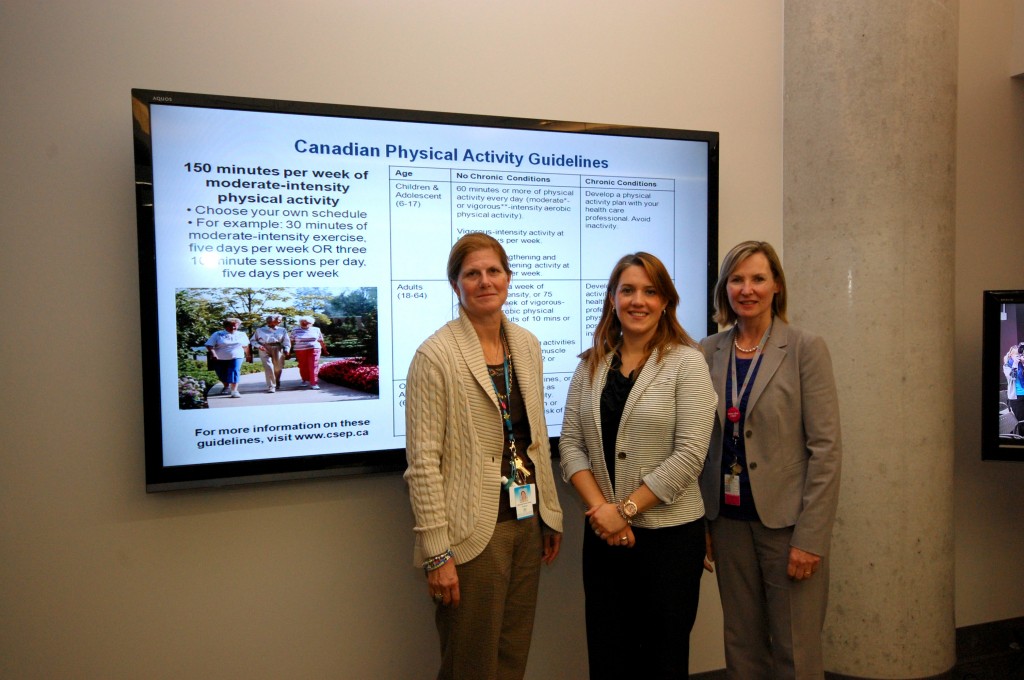(l to r: Dr. Jennifer Price, Debbie Childerhose and Women’s College Hospital Chief Nursing Executive Jane Mosley)
“It’s better to be overweight but fit, than slender and inactive when it comes to minimizing potential health risks,” said Dr. Jennifer A.D. Price to a packed room at Women’s College Hospital (WCH). The presentation on Physical Activity Assessment and Counselling: Insights from Research and Innovation, held on Tuesday, October 8, 2013, was the first Toronto Academic Health Science Network (TAHSN) Nursing Grand Research Rounds of the academic year. Price and colleagues showed that while society seems too busy to focus on exercise, that inactivity can be more deadly than obesity, hypertension, smoking, diabetes and high cholesterol. The research WCH has undertaken to improve cardiovascular health of their patients, and the role of nurses in emphasizing physical activity and health promotion highlighted the steps nursing is undertaking to raise activity levels.
The discussion was moderated by Jane Mosley, the chief nursing executive for Women’s College Hospital and co-presented by Mireille Landry, who was unable to attend but asked Deborah Childerhose to facilitate her slides. The presentation provided eye-opening information on the need for exercise. Exercise capacity naturally declines by 10 per cent per decade and therefore, the older you get it is harder to get back into shape – that is, if you’ve been in shape to begin with. If medical complications such as heart disease occur, the motivation and ability to exercise can be compromised and lead patients, especially women, to develop additional health-related issues.
“Clinically, we usually don’t ask about exercise and physical activity and this needs to change,” said Dr. Price who is an advance practice nurse of cardiology at the Women’s Cardiovascular Health Initiative at Women’s College Hospital. “It’s routine to look at blood pressure and check on weight, and now even ask about smoking but it’s necessary to the conversation to include exercise.”
Physical activity provides a greater degree of protection for women than men, regardless of age or health, and after seeing women with cardiovascular complications not engage in exercise, WCH created the Women’s Cardiovascular Health Initiative. Detailing results of some studies the Initiative have undertaken, Dr. Price presented the audience with some interesting findings. Women cited a lack of accessibility, limited referrals from physicians and not knowing how to exercise safely as the key factors for not exercising; not to mention getting back to their busy lives and after starting to feel better, downgrading the importance of physical activity. Encouraging women to use the gym at WCH as part of a post-cardiac rehabilitation program provided a specialized exercise environment, which motivated participants to attend and increase their physical activity.
Another source of encouragement for women to exercise is through support by nurses, which Childerhose detailed in Landry’s presentation. Given that the Canadian Physical Activity Guidelines outlines that adults 18-64 require 150 minutes of moderate-to-intense physical activity per week just to maintain their health, nurses are a valuable resource to get the message out and champion exercise. One way is by modifying the five “A’s” of smoking cessation to address physical activity allows nurses to: 1) Assess the issue 2) Advise change 3) Agree on an action plan 4) Assist with securing resources and 5) Arrange follow-up.
“Nurses are ideally positioned to promote physical activity and to succeed, they need the clinical tools and processes to give these assessments,” said Childerhose, a physiotherapist and program coordinator with the Women’s Cardiovascular Health Initiative. “Nurses also have the means to recognize the barriers to undertaking exercise and how to address them.”
To view the webcast of this presentation on Physical Activity Assessment and Counselling: Insights from Research and Innovation please go here.
